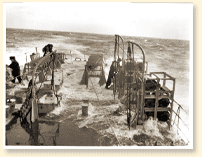

Quarterdeck of R.C.N. frigate in rough seas off Halifax, N.S., January 1944
Photo : National Defence
|
The Canadian Armed Forces: The Royal Canadian Navy (RCN)
By war's end, the Royal Canadian Navy had grown
into one of the world's great
navies -- 100,000 men and women and 365 warships. Just six years
earlier, it had been tiny, with only 3500 permanent and part-time
('reserve') members and six modern destroyers and four minesweepers.
The growth was rapid and enormous, and with it came huge problems
in training people and readying ships for sea, some of which led
to tragic losses of men and ships. The Canadian navy's main work, using small, versatile Canadian-built antisubmarine
warships known as corvettes, was as an escort force for the merchant
ships whose Atlantic Ocean cargoes were vital to Britain's survival.
This force played a decisive part in defeating the German submarines
() from
deep in the Gulf of St. Lawrence to the Arctic Circle
and the Mediterranean Sea. The contributed
mightily to other major operations, such as the landing of Allied armies on
the coast of German-occupied France on 6 June 1944. ( See D-Day and the Normandy
Campaign) One major Canadian warship
also saw action in the bitterly-fought battles against Japan in
the Pacific. The
lost 24 ships, mostly in the Atlantic, during the war. Related Newspaper Articles
English Articles
French Articles
-
La marine canadienne
Le Devoir, 18/05/1940
-
"La marine de guerre du Canada comptera 213 unités, bientôt - L'effort de guerre du Canada"
Le Devoir, 30/07/1940
-
Le Canada reçoit six destroyers des États-Unis
Le Devoir, 20/09/1940
-
La part de plus en plus importante que joue le Canada dans la guerre navale
Le Devoir, 06/02/1941
-
La marine canadienne
Le Devoir, 31/03/1941
-
Le commodore Victor-G. Brodeur
Le Devoir, 15/04/1941
-
"La marine canadienne - 27,000 hommes et 300 navires"
Le Devoir, 06/11/1941
-
"Perte d'une troisième corvette canadienne"
Le Devoir, 20/02/1942
-
Notre marine de guerre
Le Devoir, 08/05/1942
-
La femme dans l'armée. Le corps féminin de la marine royale canadienne
Le Devoir, 10/06/1942
-
L'amiral Nelles réclame plus de vaisseaux d'escorte
Le Devoir, 25/01/1943
-
Exploit accompli en Méditerranée par une corvette canadienne
Le Devoir, 01/02/1943
-
En action dans la marine
Le Devoir, 03/02/1943
-
"Ration d'urgence des hommes de la Marine: douze tablettes, douze biscuits, chocolat, eau"
Le Devoir, 04/02/1943
-
"Nos côtes seront mieux défendues, assure le ministre de la Marine"
Le Devoir, 04/03/1943
-
Navires canadiens à l'honneur
Le Devoir, 06/07/1944
-
Éloge de nos jeunes commandos
Le Devoir, 15/08/1944
-
Notre marine patrouille à elle seule tout l'Altantique-nord
Le Devoir, 06/09/1944
-
La marine canadienne dans le pacifique
Le Devoir, 04/04/1945
-
Destroyers canadiens de retour au Canada
Le Devoir, 05/06/1945
|